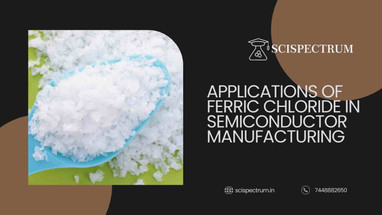Posted by Scispectrum on 22nd Aug 2025
Ferric Chloride: The Unsung Hero of Semiconductor Etching
In the intricate world of semiconductor manufacturing, where precision is paramount, chemical etching plays a pivotal role. Among the many etching agents employed, ferric chloride (FeCl3) stands out as a versatile and cost-effective solution, particularly in wet etching processes. This article delves into the multifaceted applications of ferric chloride in semiconductor manufacturing, exploring its mechanisms, advantages, and why it remains an unsung hero of this technologically advanced industry.
Etching: A Cornerstone of Semiconductor Fabrication
Before we explore the specifics of ferric chloride, let’s understand why etching is crucial in semiconductor manufacturing:
- Creating Intricate Patterns: Semiconductors rely on intricate circuit patterns etched onto wafers. Etching selectively removes material from specific areas, defining the conductive pathways, transistors, and other essential components of integrated circuits.
- Precision and Control: Etching processes demand extreme precision to create features at the nanometer scale. The choice of etching agent and process parameters directly impacts the accuracy and resolution of these features, ultimately affecting the performance and yield of the final semiconductor devices.
Ferric Chloride: A Versatile Etching Agent
Ferric chloride, often referred to as iron(III) chloride, is a chemical compound with the formula FeCl3. In semiconductor manufacturing, it’s widely used as an etchant for various materials, including:
- Copper: Ferric chloride exhibits excellent etching selectivity for copper, making it the go-to choice for etching copper interconnects in printed circuit boards (PCBs) and integrated circuits.
- Silicon: While not as common as its use with copper, ferric chloride can etch silicon under specific conditions, finding applications in microelectromechanical systems (MEMS) and sensor fabrication.
Mechanisms of Ferric Chloride Etching
The etching process with ferric chloride involves a redox reaction, where ferric ions (Fe3+) are reduced to ferrous ions (Fe2+) while oxidizing the target material. Let’s break down the mechanism for copper etching:
- Oxidation of Copper: Ferric ions in the solution oxidize copper atoms on the wafer surface, forming copper ions (Cu2+).
- Reduction of Ferric Ions: Simultaneously, ferric ions (Fe3+) are reduced to ferrous ions (Fe2+), accepting the electrons released during copper oxidation.
- Formation of Soluble Products: The resulting copper ions (Cu2+) react with chloride ions (Cl-) from the ferric chloride solution, forming soluble copper chloride complexes, which are then easily removed from the wafer surface.
Advantages of Ferric Chloride in Semiconductor Manufacturing
Several factors contribute to the popularity of ferric chloride as an etchant in the semiconductor industry:
- High Etch Rate: Ferric chloride offers a relatively high etch rate for copper, allowing for faster processing times, which is crucial for high-volume manufacturing.
- Excellent Selectivity: One of the key advantages of ferric chloride is its high selectivity for copper. This means it etches copper significantly faster than other materials commonly used in semiconductors, such as silicon dioxide (SiO2), ensuring minimal damage to adjacent layers during the etching process.
- Cost-Effectiveness: Ferric chloride is readily available and relatively inexpensive compared to some alternative etching agents, making it an economically viable option for semiconductor fabrication.
Applications Across Semiconductor Processes
Ferric chloride finds applications in various stages of semiconductor manufacturing:
- Wafer Thinning: Ferric chloride can be used to chemically thin silicon wafers, achieving precise thickness control, which is critical for advanced packaging technologies and 3D chip stacking.
- Photolithography: In photolithography, ferric chloride can etch away exposed photoresist layers, revealing the underlying material for subsequent processing steps.
- MEMS Fabrication: The anisotropic etching properties of ferric chloride on silicon are leveraged in MEMS fabrication to create complex 3D structures, such as cantilevers and membranes, used in sensors and actuators.
Environmental Considerations and Safety
While ferric chloride offers numerous advantages, it’s crucial to address environmental and safety concerns:
- Waste Disposal: Ferric chloride etching generates waste containing heavy metals. Proper treatment and disposal methods are essential to prevent environmental contamination.
- Handling Precautions: Ferric chloride solutions are corrosive and can cause skin and eye irritation. Handling should be done with appropriate personal protective equipment and in well-ventilated areas.
Conclusion: A Vital Component in Advanced Technology
Ferric chloride, despite being less discussed than some other high-tech materials in semiconductor manufacturing, plays a critical role in enabling the production of the electronic devices we rely on daily. Its effectiveness as an etchant, particularly for copper, combined with its cost-effectiveness, makes it an indispensable tool in the semiconductor industry. As technology advances and demands for smaller, faster, and more powerful devices increase, the importance of precise etching techniques, with ferric chloride at the forefront, will only continue to grow.

